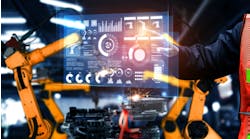Like everything else in the world of manufacturing, the supply chain is undergoing drastic change as all stakeholders throughout the chain adopt digital approaches. We chatted with Joe Limbaugh, Motion Industries’ SVP of supply chain, operations support and marketing, to get his take on what’s next.
Smart Industry: In an era of smart technology, what is the greatest next-stop opportunity in relation to the supply chain?
Joe: Like the term Supply Chain, Smart Technology can mean different things to different people. In a general sense, the idea of using data to link and drive business decisions, particularly in supply chain, can yield tremendous opportunities. For instance, today the ROI on a goods-to-person application makes this a very attractive solution to a traditional distributor. They use less real estate, utilize vertical space, and can deliver lines processed per hour (LPPH) at terrific levels. Then at the end of the shift, data is used to automatically relocate slower-moving material toward the bottom of the machine and faster-moving items toward the top, thus increasing output even more. With this type of continuous calibration, the process just keeps getting better.
Smart Industry: How willing are supply-chain managers to adopt elements of digital transformation?
Joe: I sure hope so! You do not have to look very far to see a new application or article illustrating the benefits. I have been around long enough to remember when distribution centers were regarded as necessary evils. There was no real case to be made for investment, and they looked and operated like it. Other supply chain areas, like purchasing and inventory control, operated in separate and distinct silos, so communication and resulting strategy were sparse at best. Automation began to change that, especially where sortation was concerned. Fast forward to today, and warehouse-management systems have become extremely sophisticated. Couple that with a practice that unites all supply chain departments under one structure, and you can see how the game has changed. It’s supply chain’s time in the sun! The danger is believing that one size will fit all where solutions are concerned. In many cases, it takes a combination of tools to yield the best return, especially in a DC environment. Therefore, we still need to think carefully about how to apply technology.
Smart Industry: Where do you see supply-chain strategy in ten years?
Joe: Today, as in the past, much of the data that is used to drive the process comes from internal sources. (Demand, lead times, etc.) In the future, data will be available from sources unrelated to the traditional supply chain and will be equally (if not more) impactful. Consider IIoT; sensors will communicate with other devices that will apply algorithms to accurately predict when something needs to be replaced or replenished. (Alternatively, it may indicate that something does NOT need to be replaced, so that greater risk can be taken regarding production.) Supply chains can then be leveraged to deliver items in alignment with precise demand. Looking back through the process, on-hand inventory and procurement methods will be greatly enhanced as redundant stock gets eliminated. Just imagine the effect this will have on asset management.


